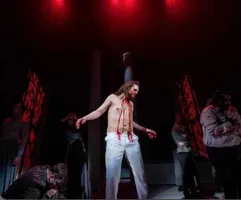
Sophocles: OEDIPUS - THE LAST PERIOD
Plague and war are raging in Thebes and people are desperate. Nature commands them to find the culprit of the disaster. Who is to blame for all this? Who caused the plague? Who bears responsibility? And so the search and hunt for the unknown culprit begins. The ruler of Thebes himself - Oedipus - takes the lead in the investigation. This Oedipus, who, before he ascended the throne of the murdered Theban king and took his wife Jocasta as his wife, solved the Sphinx's riddle. When asked who the animal with the weak voice is, which is simultaneously four-legged (tetrapus), two-legged (dipus ) , and three-legged (tripus ) , he answers that it is a human - a child in the morning, a man at noon, and an old man with a cane in the evening. This Oedipus, in whose name (oidos=pressure, pous=leg) the tragedy of his fate is encoded. But why does the blind soothsayer Teiresias say that the mysterious crime was committed by someone from the royal palace? Someone who " is both father and brother to his own children, son and husband to his own mother, and murderer and bed-sucker to his father ." And what role does Oedipus' brother-in-law Creon play in the whole affair? And what if Oedipus himself is the culprit? If only it were all different.
The production opens a new perspective on one of the most famous stories in world literature. It does not want to confirm old myths or create new ones. The universal story of the sacrificial lamb has permeated every era. In modern visuals, in addition to strong acting performances, the songs of the ancient choir performed by the opera choir are heard.
" It is clear that Oedipus, both king and lamb in one person, is actually a pharmakos, a human sacrifice ritually offered to the gods with a request to avert a plague, as we know it, for example, from Athens, from the festival of Thargelia, which is sufficiently documented. "
Location: National Theatre / Historic Building
